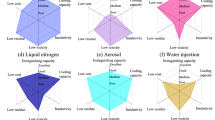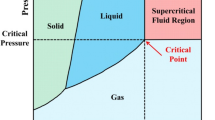Abstract
As is known there is a large amount of smoke released from the combustion process of thermoplastic polyurethane elastomer (TPU). To reduce the fire risk of TPU is one of the research contents in the fire safety fields. In this paper, [Glu]H2PW12O40 was used as smoke suppressant in TPU, and the smoke suppression effect of [Glu]H2PW12O40 was intensively investigated using nuclear magnetic resonance, scanning electron microscope, cone calorimeter test (CCT), smoke density test (SDT), and thermogravimetric analysis/infrared spectrometry, respectively. In the CCT test, the peak value of smoke production rate (SPR) of TPU-3 with 0.5 mass% of [Glu]H2PW12O40 was 0.036 m2 s−1, reduced by 75% compared with the peak SPR value of TPU-0 without [Glu]H2PW12O40 (0.145 m2 s−1). [Glu]H2PW12O40 could decrease the total smoke release (TSR) from 1560 to 694 m2 m−2. And [Glu]H2PW12O40 could decrease the smoke factor from 1838 to 538 W m−2. The SDT results showed that the luminous flux value of TPU-3 with 0.5 mass% of [Glu]H2PW12O40 decreased by 30% compared with pure TPU at the end of the test without flame. The photographs from the CCT test showed that [Glu]H2PW12O40 could promote char residue formation. TG test also revealed that [Glu]H2PW12O40 could improve the thermal stability at high temperature. At the end of thermal decomposition, the mass of TPU-3 with 0.5 mass% of [Glu]H2PW12O40 increased 6.3% compared with the mass of TPU-0 without [Glu]H2PW12O40. Based on the above result, it could be concluded that [Glu]H2PW12O40 can suppress smoke generation by promoting char generation. In addition, [Glu]H2PW12O40 has a good prospect in smoke suppression of TPU.











Similar content being viewed by others
References
Dang JM, Yu HY, Zheng CT, Wang YD, Sun YJ. An early fire sensor based on infrared gas analytical methods. Anal Methods. 2018;10(27):3325–31. https://doi.org/10.1039/c8ay00591e.
Ayala P, Cantizano A, Rein G, Gutierrez-Montes C. Factors affecting the make-up air and their influence on the dynamics of atrium fires. Fire Technol. 2018;54(4):1067–91. https://doi.org/10.1007/s10694-018-0725-z.
Wang K, Jiang SG, Ma XP, Wu ZY, Shao H, Zhang WQ, et al. Numerical simulation and application study on a remote emergency rescue system during a belt fire in coal mines. Nat Hazards. 2016;84(2):1463–85. https://doi.org/10.1007/s11069-016-2538-z.
Tabuani D, Belluccia F, Camino G. Flame retarded thermoplastic polyurethane (TPU) for cable jacketing application. Polym Degrad Stab. 2012;97(12):2594–601.
Cai W, Wang J, Pan Y, Guo W, Mu X, Feng X, et al. Mussel-inspired functionalization of electrochemically exfoliated graphene: based on self-polymerization of dopamine and its suppression effect on the fire hazards and smoke toxicity of thermoplastic polyurethane. J Hazard Mater. 2018;352:57.
Ji X, Chen D, Wang Q, Shen J, Guo S. Synergistic effect of flame retardants and carbon nanotubes on flame retarding and electromagnetic shielding properties of thermoplastic polyurethane. Compos Sci Technol. 2018;163:49–55.
Pinto UA, Visconte LLY, Gallo J, Nunes RCR. Flame retardancy in thermoplastic polyurethane elastomers (TPU) with mica and aluminum trihydrate (ATH). Polym Degrad Stab. 2000;69(3):257–60.
Wang BB, Sheng HB, Shi YQ, Song L, Zhang Y, Hu Y, et al. The influence of zinc hydroxystannate on reducing toxic gases (CO, NOx and HCN) generation and fire hazards of thermoplastic polyurethane composites. J Hazard Mater. 2016;314:260–9. https://doi.org/10.1016/j.jhazmat.2016.04.029.
Yang HY, Song L, Hu Y, Yuen RKK. Diphase flame-retardant effect of ammonium polyphosphate and dimethyl methyl phosphonate on polyisocyanurate-polyurethane foam. Polym Adv Technol. 2018;29(12):2917–25. https://doi.org/10.1002/pat.4411.
Wei Z, Syed NA, Muhammad L, Jung-Il S. Fabrication of self-reinforced polyester composites and their mechanical and flame retardant properties. Adv Polym Technol. 2018;37(7):2436–45. https://doi.org/10.1002/adv.21918.
Jiao CM, Wang HZ, Zhang ZB, Chen XL. Preparation and properties of an efficient smoke suppressant and flame-retardant agent for thermoplastic polyurethane. Polym Adv Technol. 2017;28(12):1690–8. https://doi.org/10.1002/pat.4041.
Zhang B, Liu H, Han J. Aluminum phosphate microcapsule flame retardants for flexible polyurethane foams. J Phys Chem Solids. 2018;115:199–207. https://doi.org/10.1016/j.jpcs.2017.12.048.
Chen XL, Wang WD, Jiao CM. A recycled environmental friendly flame retardant by modifying para-aramid fiber with phosphorus acid for thermoplastic polyurethane elastomer. J Hazard Mater. 2017;331:257–64. https://doi.org/10.1016/j.jhazmat.2017.02.011.
Rao WH, Liao W, Wang H, Zhao HB, Wang YZ. Flame-retardant and smoke-suppressant flexible polyurethane foams based on reactive phosphorus-containing polyol and expandable graphite. J Hazard Mater. 2018;360:651–60. https://doi.org/10.1016/j.jhazmat.2018.08.053.
Dizaji AK, Mokhtarani B, Mortaheb HR. Deep and fast oxidative desulfurization of fuels using graphene oxide-based phosphotungstic acid catalysts. Fuel. 2019;236:717–29. https://doi.org/10.1016/j.fuel.2018.09.076.
Zhang S, Yan Y, Wang W, Gu X, Li H, Li J, et al. Intercalation of phosphotungstic acid into layered double hydroxides by reconstruction method and its application in intumescent flame retardant poly (lactic acid) composites. Polym Degrad Stab. 2018;147:142–50.
Qin LB, Zheng Y, Li DQ, Zhou YS, Zhang LJ, Zuhra Z. Phosphotungstic acid immobilized on amino functionalized spherical millimeter-sized mesoporous gamma-Al2O3 bead and its superior performance in oxidative desulfurization of dibenzothiophene. Fuel. 2016;181:827–35. https://doi.org/10.1016/j.fuel.2016.05.063.
Morgan AB, Bundy M. Cone calorimeter analysis of UL-94 V-rated plastics. Fire Mater. 2010;31(4):257–83.
Puente E, Lazar D, Alvear D. Study of tunnel pavements behaviour in fire by using coupled cone calorimeter—FTIR analysis. Fire Saf J. 2016;81:1–7. https://doi.org/10.1016/j.firesaf.2016.01.010.
Shen RQ, Hatanaka LC, Ahmed L, Agnew RJ, Mannan MS, Wang QS. Cone calorimeter analysis of flame retardant poly (methyl methacrylate)-silica nanocomposites. J Therm Anal Calorim. 2017;128(3):1443–51. https://doi.org/10.1007/s10973-016-6070-x.
Chen X, Liu L, Jiao C, Qian Y, Li S. Influence of ferrite yellow on combustion and smoke suppression properties in intumescent flame-retardant epoxy composites. High Perform Polym. 2015;27(4):412–25.
Liu L, Chen XL, Jiao CM. Influence of ferrocene on smoke suppression properties and combustion behavior of intumescent flame-retardant epoxy composites. J Therm Anal Calorim. 2015;122(1):437–47. https://doi.org/10.1007/s10973-015-4928-y.
Huang JL, Liu JY, Chen JC, Xie WM, Kuo JH, Lu XW, et al. Combustion behaviors of spent mushroom substrate using TG-MS and TG-FTIR: thermal conversion, kinetic, thermodynamic and emission analyses. Bioresour Technol. 2018;266:389–97. https://doi.org/10.1016/j.biortech.2018.06.106.
Shen J, Liu JX, Xing YF, Zhang H, Luo L, Jiang XM. Application of TG-FTIR analysis to superfine pulverized coal. J Anal Appl Pyrolysis. 2018;133:154–61. https://doi.org/10.1016/j.jaap.2018.04.007.
Ferreira RAD, Meireles CD, Assuncao RMN, Soares RR. Heat required and kinetics of sugarcane straw pyrolysis by TG and DSC analysis in different atmospheres. J Therm Anal Calorim. 2018;132(3):1535–44. https://doi.org/10.1007/s10973-018-7149-3.
Chen X, Wang W, Jiao C. A recycled environmental friendly flame retardant by modifying para-aramid fiber with phosphorus acid for thermoplastic polyurethane elastomer. J Hazard Mater. 2017;331:257.
Jiao C, Wang H, Li S, Chen X. Fire hazard reduction of hollow glass microspheres in thermoplastic polyurethane composites. J Hazard Mater. 2017;332:176.
Acknowledgements
The authors gratefully acknowledge the National Natural Science Foundation of China (Nos. 51776101, 51206084), the Natural Science Foundation of Shandong Province (ZR2017MB016), and the Project of the State Administration of Work Safety (shandong-0039-2017AQ).
Author information
Authors and Affiliations
Corresponding author
Additional information
Publisher's Note
Springer Nature remains neutral with regard to jurisdictional claims in published maps and institutional affiliations.
Rights and permissions
About this article
Cite this article
Jiao, C., Li, M., Zhang, X. et al. Smoke suppression of [Glu]H2PW12O40 in thermoplastic polyurethane elastomer. J Therm Anal Calorim 143, 535–544 (2021). https://doi.org/10.1007/s10973-019-09134-3
Received:
Accepted:
Published:
Issue Date:
DOI: https://doi.org/10.1007/s10973-019-09134-3




